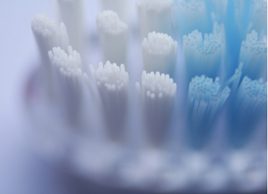The oral-care products you really need
Shopping the dental-care aisle can be a confusing experience. Here are some expert picks on what you really need to keep your teeth and gums (and whole body) healthy

Source: Best Health Magazine, March/April 2009
Taking care of your teeth and gums means more to your health than just having a cavity-free mouth. Good oral care reduces gum disease and halitosis, and helps you avoid tooth loss. Beyond that, poor oral health is linked to cardiovascular and respiratory diseases, and diabetes. "Oral health is an essential part of overall health," says Deborah Stymiest, president of the Canadian Dental Association (CDA) and a dentist in Fredericton. But with the ever-growing array of oral-care products on the market today, how do you choose what works? We’ve asked the experts for their best bets.
Manual toothbrushes
The latest toothbrushes showcase a variety of angles and multi-height bristles for better reach, and ergonomic or easy-grip handles. They may include tongue and even cheek cleaners. There isn’t yet the research to prove those do a better job of cleaning your teeth, but some studies show that tongue cleansing will cut the amount of bacteria in your mouth (although there’s no evidence that it reduces oral disease).
Expert advice: Avoid a brush head that seems too big in your mouth. An oversized or ergonomic handle might be useful if you have manual dexterity problems. As for the other bells and whistles: ‘Almost any appropriately sized toothbrush will be effective if you use it regularly and for enough time,’ says Joanna Asadoorian, an associate professor in the faculty of dentistry at the University of Manitoba. That means brushing at least twice a day for at least two minutes each time. It’s often recommended that toothbrushes be replaced every three months, but research has shown that individuals wear them out at different rates, so look at the condition of your toothbrush as an indicator of when it’s time to replace it rather than going by a set time frame. You’ll know it’s time to replace it when the bristles become splayed or bent.
Power toothbrushes
Some new rechargeable battery-powered toothbrushes tout sonic vibration, with more strokes per minute’20,000 or more’than less expensive models at 7,000. Some high-tech brushes signal when you’re applying too much pressure, and the new Oral-B Triumph toothbrush with SmartGuide even has an LCD display with a diagram to tell you where to brush, and a digital readout to tell you how much longer.
Does that translate into better brushing? Research is inconclusive. But, says Stymiest: ‘Brushing with a manual toothbrush, if you’re doing it properly, is as effective as any type of mechanical brush.’
Expert advice: While using a power toothbrush may not necessarily do a better job than a manual toothbrush, any engaging feature that motivates you to brush your teeth properly is going to make a difference in terms of your oral health. ‘People really have to choose something that they are going to like to use,’ says Asadoorian. ‘That will help keep them brushing longer and more regularly.’
Toothpaste
Many toothpastes contain plaque-fighting ingredients such as triclosan and xylitol. And Bionic Gel toothpaste, from a U.S.-based company, actually contains silver particles purported to battle gum disease and tooth decay. It’s available in Canada at some health food stores and dentist offices. As yet, no one brand of toothpaste has been proven superior to all the others.
Expert advice: What matters most is that your toothpaste contains fluoride and that it’s not overly abrasive. ‘Look for a product that has been scientifically and clinically tested,’ says Stymiest. When shopping for a toothpaste, check for a seal of recognition by the CDA on the packaging, as not all products will have this. Products with the seal have been reviewed by the CDA and are considered good for contributing to oral health.
Interdental products
Not only does flossing help prevent gum disease, but it may actually stave off heart disease. So clean between your teeth at least once a day, say experts. ‘Despite how effective you are with brushing, without flossing you may still be leaving about 30 percent of the plaque between your teeth,’ Stymiest notes. Interdental brushes such as Proxabrush and Sulcabrush will also do the trick with their narrow sets of bristles that work to clean between the teeth and along the gum line. Clinical trials have shown that water jets that blast debris from between your teeth and around your gums are as beneficial as flossing, as long as you use them with sufficiently high power. Waterpik and Conair both offer small, lightweight cordless designs.
Expert advice: Go on personal preference, since water jets and interdental brushes both typically measure up to flossing. If you have difficulty handling floss, you may find that water jets are the easiest way to go.
Mouthwash
Various mouthwashes on the market contain silver, calcium or even tea tree oil, but in clinical trials of non-prescription rinses, Listerine consistently comes out on top. For those who don’t like that it contains alcohol, however, the new alcohol-free Crest Pro-Health Rinse is showing comparable results. Other alcohol-free brands of mouthwash that are showing clinical effectiveness in trials are slated to come to store shelves soon.
Expert advice: ‘While mouthwash isn’t always essential for good oral health, it does freshen your mouth,’ says Asadoorian. ‘And some over-the-counter brands decrease bacteria and can prevent gingivitis beyond what’s achieved with brushing and flossing.’
This article was originally titled "Time For a New Toothbrush?" in the March/April 2009 issue of Best Health Magazine. Subscribe today and never miss an issue!




